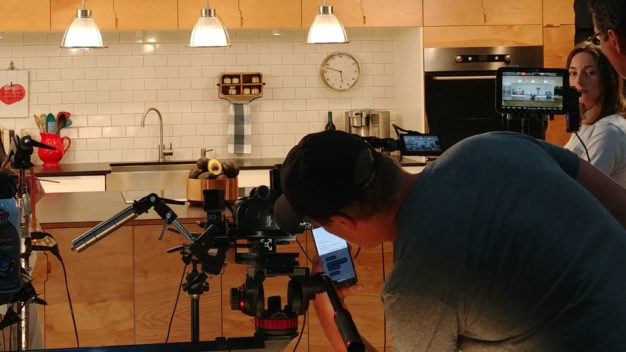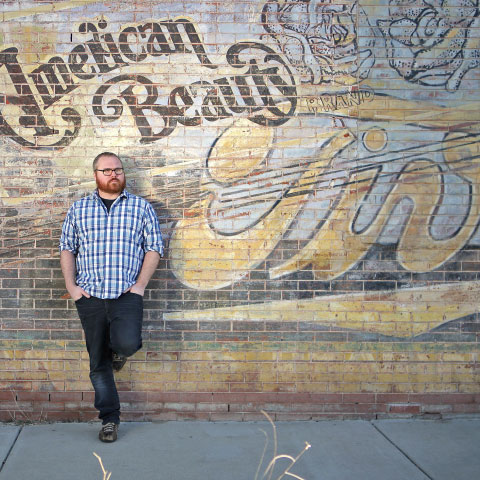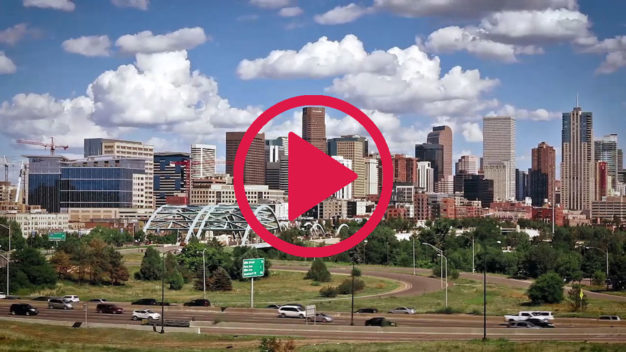You have a camera. You have a script, or an idea, or even just an inclination to create a visual piece of art. What can you do with your camera to make this creation visually interesting for your audience? MOVE THE CAMERA. They call ‘em movies for a reason.
The camera is your audience’s eye into the world you’re creating. So take them on a ride. A locked-off (or motionless) camera is, more often than not, pretty boring. However, don’t move the camera just to move it. The movement needs to complement the story in some form. The movement should move your audience emotionally.
Here’s some basic camera moves:
 PAN
PAN
Short for panoramic, the camera rotates to the left or right, usually from a tripod. The pan can be used to follow action in a scene from left to right, like a Westerner would read a book. Or the opposite direction. The camera can pan in a full 360 degrees to show an entire environment. Or it can be used for a terrifying scene like Kubrick did in the famous axing-of-the-door scene in The Shining. Pans are great for horizontal compositions that can unfold information to the audience. I especially love the way Wes Anderson uses it for reaction shots. Careful, that supercut might make you dizzy.
TILT
With a Tilt, the camera rotates up and down, also generally from a tripod. The tilt can show scale of height or a character’s physique. Tilting up to a character can show their dominance, tilting down can show their submission. It can also be used for a surprise like when the goat disappeared in Jurassic Park (example at about 0:47).
JIB, CRANE, BOOM or PEDESTAL
The Jib Shot is a vertical move, where the entire camera is raised or lowered. The term Pedestal refers to very heavy cameras and the rigs needed to hold them. It’s not a widely used term though. This move can be more effective than a Tilt because you’re actually moving your audience’s perspective in the scene, rather than locking them on a tripod. Orson Welles crushed this move in Citizen Kane. A Jib Shot can show the scale of a scene or show your hero in all their glory. Generally a crane is larger than a jib, giving a larger range of motion. Some geniuses out there figured out how to mount a jib on a moving vehicle. It’s called a Russian Arm most often.
ZOOM
Everybody probably knows what this is, or what it looks like, but not necessarily what’s happening. It’s this: Changing the focal length on your lens to change the Field of View. You can combine this with the Dolly Shot to create a Zolly Shot. This combo has been around for awhile but here’s a cool example from Guardians of the Galaxy Vol. 2 at 1:09.
DOLLY
The Dolly is a movement towards or away from a subject, and most likely the camera is mounted on tracks that allow for a smooth traverse of the scene. The Dolly is usually chosen over a Zoom because you can change the composition of a setting without changing the focal length, which can distort the image. It’s all about what you want to accomplish. Spike Lee puts his characters on the dolly and moves them through a scene.
TRUCKING / TRACKING
The Tracking Shot is very much like a Dolly, but the cameras moves laterally to a subject, rather than toward or away. This Shot is great for showing a character moving through an environment while keeping them on a flat plane. I’m one of the insufferable Kubrick hounds, so here’s a great meta-example of this type of shot from Full Metal Jacket.
STABILIZED
The Stabilized Shot (or the branded term Steadicam shot) is used all the time. By strapping the camera to a stabilizing rig strapped to a camera operator, the camera can move through a scene almost like it’s floating. The stabilization turns down the nausea, and the movement makes the audience feel as though they are literally walking through a scene. This shot is great for Point-of-View shots, as well as action scenes.
HANDHELD
The Handheld Shot is basically the Stabilized Shot, without the stabilization (to some degree, at least). These shots have become a staple in cinema and television, and we took a crack at it with this award-winning video for Thornton Water. This technique is arguably more immersive, as it more closely resembles the experience of an audience member in real life. The shaky camera and jerky movements can add a tension to a scene. Be careful, you can give your audience motion sickness, or look like an amateur if these shots are used in the wrong way.
For a great example of how all of these can be used in a single piece, check out the video we produced for BP below. When it comes to creating engaging video content, always be thinking about how you could move your audience in the right direction.


